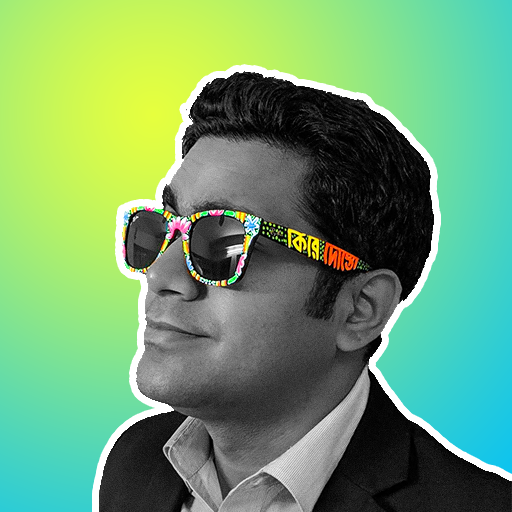Connecting you to what matters most. Empowering societies.
On November 30, 2020, I completed my 5 years in Telenor. Having worked in two extraordinary business units (Bangladesh and Thailand) already, I feel extremely grateful for all the lessons learned, contributions made, and personal growth over the past 5 years. Being both an outsider to the telecom industry at the time I joined and now being an insider, I want to share 5 of my compelling reflections for anyone who is interested to know the industry better, and find future opportunities!
Joining Grameenphone — The biggest Telenor business unit by subscriber base
I had never formally applied for a job in my whole career and it wasn’t any different during my joining of Grameenphone. As a matter of fact, I didn’t know anyone personally except Nehal Ahmed, the then Marketing Director of GP, and who was my ex-boss at QUBEE I, on the other hand, was just in the middle of my second career sabbatical after the acquisition of G&R Technologies, the largest local display ad network in Bangladesh. Compared to GP, G&R was a tiny startup that was ahead of its time, evangelizing the digital marketing boom that we see in Bangladesh today. I wasn’t sure where I would move next. I had a few offers in Dhaka, but I was in no rush.
On Friday, 27 November 2015, at around 9 pm at night, I was enjoying a live concert at the Bengal Music Fest among thousands of other music lovers with my then-girlfriend (now my wife), when I received a call from an unknown GP number. As I picked up the call, the voice on the other side replied, “Hi Salman, this is Azman speaking”. Not knowing anyone by that name, I replied, “I’m sorry, Azman, who?”. Without taking any offense, the voice replied, “I am Yasir Azman, the CMO of Grameenphone speaking”. At that very moment, I realized what blunder it was of me to not recognize the first-ever Bangladeshi CMO of Grameenphone, one of the most successful corporate leaders of our country! I immediately expressed my apology for not recognizing him (I never met or spoke to him before) and told him how excited I was to have his call. I told him about the loud atmosphere around me and it was hardly possible to clearly hear him. As it will be late by the time I’m back home, I offered to call him the next day if it was okay. But Azman Bhai insisted that I listen to his ‘pitch’ for me, implying his agenda to call me at that late hour (Friday is a weekend in Bangladesh). Understanding this wasn’t a call I could return, I sprint out of the stadium, called him back and we ended up having almost a 30 mins conversation! Azman Bhai told me about his vision to transform the telecom ecosystem through digital transformation. And he needed someone to come with a digital native leadership background, with an outside-in view to help drive the digitization of the core in Grameenphone. Without hesitation, I humbly accepted his offer to join Grameenphone under his leadership, and the rest is pretty much history!
5 reflections from my 5-year career in Telenor
1. Size doesn’t matter!
Most people tend to believe that large companies can easily build a scalable product, and that too with a deep pocket of continuous investments. While this probably is true for some companies, when it comes to Telenor, this isn’t the case. When I joined GP back in 2015 and took on the ambition to launch the first telco end to end eCommerce in Bangladesh, with a team of only 3 members, we had to be frugal from the start, as we were working at that time to pull off this full vertical as part of the digitization of the core. And when we went live with this platform in 2016, we didn’t spend any money on 360 ATL campaigns like most people would think we would do. It was total hustling from day one with a small budget on targeted social media. We were not even given access to the core distribution channel of GP from day one as we needed to show validation of the product first, get some traction, and only then have more doors unlocked for us. We operated the same way a startup would. With seed money given to our team (it was at least 10 times smaller than the seed funding Bangladeshi startups receive these days), we had to bootstrap the entire solution from the ground up. The same thing happened when I took on the responsibility to launch the MyGP 2.0 (MyTelenor App), the first Telco++ self-care app in Bangladesh. With a really conservative budget, we had to rebuild the app and develop a new backend core with a whole new set of APIs connecting to both the telco systems as well as any 3rd party systems. Even after being at the forefront of what we were building, the leadership team always kept us in check on how efficiently we could operate to reduce any waste while delivering the best product in the market. To this day, based on the direct feedback I have received, MyGP is still one of the best apps ever made in Bangladesh and within the Telenor ecosystem. It’s also held as the pioneer of the new generation of advanced apps in the country among the developer and startup community. All of these happened without an open cheque, without the no-questions-asked access to GP’s own distribution system, and without getting unfair advantage by GP’s massive core products during the first 2 years. None of these would have been possible if it wasn’t for the right leadership and startup mindset among the key stakeholders involved.
2. We take the service of telecom for granted
As I was getting inducted by Shabbir Hossain (the best mentor one can ever have) after joining Grameenphone, I focused on the history of the company instead of jumping into work in full swing. I wanted to know this 20-year-old company better, one that has been part of the major developments that happened in Bangladesh over the last two decades. GP started its operation in Bangladesh when it had only around 450K registered landlines (telephones) nationwide among the 120 million population. The country hardly had any infrastructure nationwide that could support the growing need to communicate among the millions. Even the physical communication systems were broken, and in many cases, even absent. The literacy rate in the country was quite low and cellular phones were considered an elite luxury. Despite all these limitations and uncertainties, GP launched its mobile connectivity service, not with the urban rich but with women residing in villages. A group of people that any product or marketing genius would label as ‘unserviceable’. The goal was to connect the unconnected — empowering societies to what matters most.
Imagine waking up in the morning, reaching out to your phone to check your Facebook, Instagram, or any other social media channels to see it’s not refreshing since last night. Think of the Uber you need to call to commute to work is out of service. The news you must read before you head out this morning is not loading. You cannot call your mother to hear her voice before entering the office. Back home after a tiring day to binge-watch your favorite show on Netflix only to find the service is no longer available. And you also cannot call your friends as you ran out of credit balance with no nearby retail shops to recharge your phone wallet. The list is endless. Think of everything you do with your phone, that’s hanging on the single biggest value of the connectivity that’s made available to you by your telecom operator every single day and every waking hour of your life. I wish we, the users of the telecom services, appreciated it a little more. Perhaps more publicly like we do for other apps and services. I wish people knew more about the champions of our industry, the hard-work that we put in round the clock to keep them always on air, be it online or offline (voice calls and last mile physical distribution centers).
3. A strong leadership team is critical in driving success through innovation
Prior to joining GP and dtac both, I was warned by a lot of people about the many challenges I would have to face in delivering my ambition or navigating through the organization. While this is not uncommon for many large enterprises, I for some reason never cared much about what people commented from the outside. My goal was simple — to create magic and do something big for society based on the opportunity given to me.
Grameenphone’s digital success is celebrated today because of the key management ownership and sponsorship that all of us received throughout our early days. When a lot of people inside and out questioned our ambition and often created bottlenecks, it was the leadership team who believed in us, giving us the room to focus and do what was most critical for the future of the company. The same story continued as I moved to dtac and took on an even difficult role of leading the innovation department. To digitize existing core business is much easier (given the need is already recognized) compared to developing a completely new digital business/solution that doesn’t have any direct relations or dependency to the core. It is a daunting task in any given situation. When we were collaborating with Yara to build the first digital farming community platform (Kaset GO) here in Thailand, it was the same leadership farsightedness and ring-fencing of the team to focus on real results that led to our early success (you’ll find a deep dive on this innovation project here). In addition to building a whole new vertical for future business revenue for the company, we managed to integrate this platform directly to one of our core business strategies — winning the mass Thai segments through empowerment.
4. Being an outsider can be both daunting and rewarding at the same time
Coming from a 20 people startup organization to a 3000+ people enterprise is scary to begin with. On top, having the responsibility to build the unknown (digital channels and distribution) for millions of users while operating within a legacy organization was not easy. On one hand, you have the urge to fit in and change the world, on the other, you’re a nobody with no prior experience in building something at a massive scale.
Despite all, what was most rewarding when building future-proof solutions from the scratch was the outside in, unbiased view that I brought in with myself. With an open mind to listen and learn, while bringing in my understanding of the digital customers in a changing landscape, I could connect the dots much faster. I could easily flag the noises around me or in the systems. It also enabled me to see the strengths among people and in the core systems, which most people ignored or took for granted to pursue anything beyond. Whether it’s Telenor or any corporate, having an inflow of new talents and industry experts is always much rewarding for the company when striving for people excellence. Having the right diversity of people within the organization can go a long way in upskilling the company. Afterall, we cannot change the problem at hand, with what caused the problem in the first place.
5. Connecting a billion users should be a mission for Telenor
Finally and probably the most important among all the reflections is this one. Connectivity has been Telenor’s domain for more than 160 years. Telenor currently operates in 9 Nordic and Asian countries with over 180 million subscribers. In recent years, telecom operators’ growth in customer base slowed down naturally while the customer relationships between the telecoms and the end users are only getting weaker each day. Customers who use data or voice service from a telco hardly consider it as a value addition since connectivity is no longer a luxury but a commodity for all. It is a default of our life to live with all the ‘want to have’ products and services around us. In parallel, the way connectivity technologies are evolving around the world, in a matter of decade or so, my contention is that we will have a new generation of internet companies along with privately owned connectivity spectrums disrupting the whole telecom ecosystem like never before. This is on top of the internet giants already encroaching in our core systems and solutions. Given this reality, leading operators like Telenor could move out of its comfort zone of monetizing only its own network into the creation of more network agnostic customer centric products to secure a more sustainable future with a diversified portfolio. With the current operating model, a telecom operator can either add marginal growth of subscribers or add a significant new base through M&A at cost. However, by pivoting the focus towards building or co-creating innovative digital solutions that will help serve more minutes of the customer’s life (B2C and B2B combined), we can deliver great value at an unprecedented scale. It is only through a network agnostic platform solution that Telenor (or any telecom) can aim to operate as a 1 billion users platform technology company in Asia alone.
End note
Working with a higher purpose in life has always been my true north. The last 5 years in the telecom industry has been truly transformative for me as much as it is for the industry. With Covid-19 accelerating the adoption of technology at an unprecedented scale, there couldn’t be a better time to reconsider the future that we can offer to the billions of people around the world. When the mission is to connect people to ‘what matters most’, it’s already an implied direction to explore what lies beyond connectivity for our customers.
Thanks a lot for reading! If you would like to get my curated reflections on personal transformation and how to accelerate your learning for a better future, please join my newsletter list! ❤






